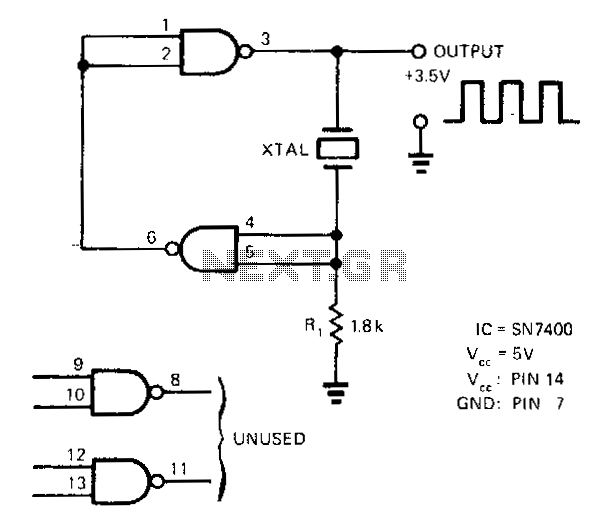
Two-gate-quartz-oscillator

A SN7400 quartz crystal and a resistor provide a square-wave output of approximately 3.5 V. The circuit operates reliably at frequencies from 120 kHz to 4 MHz.
The circuit utilizes a SN7400 integrated circuit, which is a quad two-input NAND gate, in conjunction with a quartz crystal oscillator and a resistor to generate a square-wave output. The SN7400 is chosen for its ability to produce stable and reliable digital signals, which is essential for applications requiring precise timing or clock signals.
The quartz crystal is a critical component in this configuration, as it determines the frequency of oscillation. The selected crystal frequency can range between 120 kHz and 4 MHz, allowing for versatility in different applications. The resistor serves to set the gain of the NAND gate and helps stabilize the oscillation process, ensuring that the output remains within the desired specifications.
The output voltage of approximately 3.5 V indicates that the circuit is designed to interface with standard digital logic levels, making it suitable for driving other digital circuits or components. The square-wave output can be utilized in various applications, including clock generation for microcontrollers, timing circuits, and signal modulation.
To enhance the performance and reliability of the circuit, proper layout and component selection are essential. Decoupling capacitors should be placed close to the power supply pins of the SN7400 to minimize noise and ensure stable operation. Additionally, the crystal should be mounted in a manner that reduces mechanical stress and minimizes the risk of frequency drift due to temperature changes.
Overall, this configuration provides a simple yet effective solution for generating square-wave signals in a range of electronic applications, leveraging the advantages of the SN7400 and quartz crystal technology.A SN7400 quartz crystal and a resistor provide a square-wave output of approximately 3.5 V. The circuit operates reliably at frequencies from 120 kHz to 4 MHz. 🔗 External reference
The circuit utilizes a SN7400 integrated circuit, which is a quad two-input NAND gate, in conjunction with a quartz crystal oscillator and a resistor to generate a square-wave output. The SN7400 is chosen for its ability to produce stable and reliable digital signals, which is essential for applications requiring precise timing or clock signals.
The quartz crystal is a critical component in this configuration, as it determines the frequency of oscillation. The selected crystal frequency can range between 120 kHz and 4 MHz, allowing for versatility in different applications. The resistor serves to set the gain of the NAND gate and helps stabilize the oscillation process, ensuring that the output remains within the desired specifications.
The output voltage of approximately 3.5 V indicates that the circuit is designed to interface with standard digital logic levels, making it suitable for driving other digital circuits or components. The square-wave output can be utilized in various applications, including clock generation for microcontrollers, timing circuits, and signal modulation.
To enhance the performance and reliability of the circuit, proper layout and component selection are essential. Decoupling capacitors should be placed close to the power supply pins of the SN7400 to minimize noise and ensure stable operation. Additionally, the crystal should be mounted in a manner that reduces mechanical stress and minimizes the risk of frequency drift due to temperature changes.
Overall, this configuration provides a simple yet effective solution for generating square-wave signals in a range of electronic applications, leveraging the advantages of the SN7400 and quartz crystal technology.A SN7400 quartz crystal and a resistor provide a square-wave output of approximately 3.5 V. The circuit operates reliably at frequencies from 120 kHz to 4 MHz. 🔗 External reference